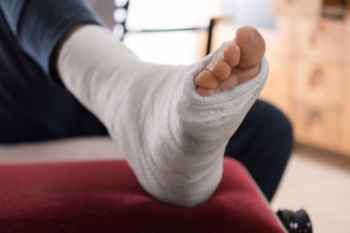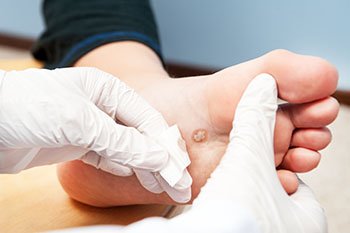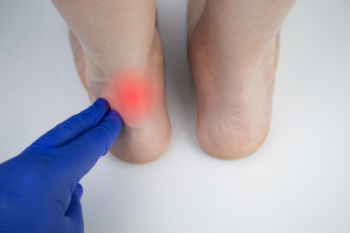Items filtered by date: May 2025
Are You Suffering From Nerve Damage?
Understanding Lisfranc Injuries

Lisfranc injuries result if bones in the midfoot are broken or ligaments that support the midfoot are torn. The midfoot is key to foot stability and arch support. Injuries can result from trauma, such as a fall, car accident, or sports injury, even something as simple as twisting the foot awkwardly. Although rare, Lisfranc injuries are often mistaken for a simple sprain. Symptoms include swelling, bruising on the top and bottom of the foot, pain while standing or walking, and difficulty bearing weight. The foot may appear misaligned or feel unstable. Left untreated, a Lisfranc injury can lead to chronic pain, arthritis, and long-term disability. A podiatrist can diagnose a Lisfranc injury through a physical exam and imaging tests like X-rays, MRI or CT scans. Treatment depends on severity and may include rest, immobilization with a cast or boot, targeted exercises, or surgical repair to realign and stabilize the bones. If you think you may have this condition, it is suggested that you schedule an appointment with a podiatrist for appropriate treatment.
A broken foot requires immediate medical attention and treatment. If you need your feet checked, contact Shawn Echard, DPM from Laurel Podiatry LLC. Our practitioner can provide the care you need to keep you pain-free and on your feet.
Broken Foot Causes, Symptoms, and Treatment
A broken foot is caused by one of the bones in the foot typically breaking when bended, crushed, or stretched beyond its natural capabilities. Usually the location of the fracture indicates how the break occurred, whether it was through an object, fall, or any other type of injury.
Common Symptoms of Broken Feet:
- Bruising
- Pain
- Redness
- Swelling
- Blue in color
- Numbness
- Cold
- Misshapen
- Cuts
- Deformities
Those that suspect they have a broken foot shoot seek urgent medical attention where a medical professional could diagnose the severity.
Treatment for broken bones varies depending on the cause, severity and location. Some will require the use of splints, casts or crutches while others could even involve surgery to repair the broken bones. Personal care includes the use of ice and keeping the foot stabilized and elevated.
If you have any questions please feel free to contact our offices located in Greensburg and Somerset, PA . We offer the newest diagnostic and treatment technologies for all your foot and ankle needs.
Plantar Warts and Prevention Tips

A plantar wart is a small growth that appears on the bottom of the foot and is caused by the human papillomavirus. This virus enters the body through tiny cuts or breaks in the skin and thrives in warm, moist environments such as public showers, locker rooms, and around swimming pools. Plantar warts often appear as rough, grainy lesions with black pinpoints in the center and can cause discomfort or pain when walking. The virus spreads through direct contact, either person to person or from contaminated surfaces. Wearing shoes in public areas, keeping feet clean and dry, and avoiding contact with existing warts can help reduce the risk of infection. As they grow inward, plantar warts can be painful as a result of standing or walking for long periods. If you have developed this condition, it is suggested that you promptly consult a podiatrist who can offer effective treatment solutions.
Plantar warts can be very uncomfortable. If you need your feet checked, contact Shawn Echard, DPM from Laurel Podiatry LLC. Our practitioner will assist you with all of your foot and ankle needs.
About Plantar Warts
Plantar warts are the result of HPV, or human papillomavirus, getting into open wounds on the feet. They are mostly found on the heels or balls of the feet.
While plantar warts are generally harmless, those experiencing excessive pain or those suffering from diabetes or a compromised immune system require immediate medical care. Plantar warts are easily diagnosed, usually through scraping off a bit of rough skin or by getting a biopsy.
Symptoms
- Lesions on the bottom of your feet, usually rough and grainy
- Hard or thick callused spots
- Wart seeds, which are small clotted blood vessels that look like little black spots
- Pain, discomfort, or tenderness of your feet when walking or standing
Treatment
- Freezing
- Electric tool removal
- Laser Treatment
- Topical Creams (prescription only)
- Over-the-counter medications
To help prevent developing plantar warts, avoid walking barefoot over abrasive surfaces that can cause cuts or wounds for HPV to get into. Avoiding direct contact with other warts, as well as not picking or rubbing existing warts, can help prevent the further spread of plantar warts. However, if you think you have developed plantar warts, speak to your podiatrist. He or she can diagnose the warts on your feet and recommend the appropriate treatment options.
If you have any questions please feel free to contact our offices located in Greensburg and Somerset, PA . We offer the newest diagnostic and treatment technologies for all your foot and ankle needs.
Managing Bunions as You Age

As you age, managing bunions becomes important for maintaining mobility and comfort. A bunion is a bony bump that forms at the base of the big toe, often caused by years of pressure, wearing improper footwear, or genetic factors. Over time, the joint can become more stiff and painful, especially during walking or standing. Choosing supportive shoes with a wide toe box helps reduce pressure on the bunion and prevents further irritation. Gentle stretching and strengthening exercises can improve joint flexibility and ease discomfort. Custom orthotics may also help realign the foot and reduce stress on the affected area. If you have a bunion that is causing any discomfort, it is suggested that you consult a podiatrist who can offer effective relief and treat methods.
If you are suffering from bunion pain, contact Shawn Echard, DPM of Laurel Podiatry LLC. Our practitioner can provide the care you need to keep you pain-free and on your feet.
What Is a Bunion?
Bunions are painful bony bumps that usually develop on the inside of the foot at the joint of the big toe. As the deformity increases over time, it may become painful to walk and wear shoes. Women are more likely to exacerbate existing bunions since they often wear tight, narrow shoes that shift their toes together. Bunion pain can be relieved by wearing wider shoes with enough room for the toes.
Causes
- Genetics – some people inherit feet that are more prone to bunion development
- Inflammatory Conditions - rheumatoid arthritis and polio may cause bunion development
Symptoms
- Redness and inflammation
- Pain and tenderness
- Callus or corns on the bump
- Restricted motion in the big toe
In order to diagnose your bunion, your podiatrist may ask about your medical history, symptoms, and general health. Your doctor might also order an x-ray to take a closer look at your feet. Nonsurgical treatment options include orthotics, padding, icing, changes in footwear, and medication. If nonsurgical treatments don’t alleviate your bunion pain, surgery may be necessary.
If you have any questions, please feel free to contact our offices located in Greensburg and Somerset, PA . We offer the newest diagnostic and treatment technologies for all your foot care needs.
Understanding the Achilles Tendon and How It Heals

The Achilles tendon is the thick band of tissue that connects the calf muscles to the heel bone. It helps you walk, run, and jump by allowing your foot to push off the ground. Because it handles so much force, it can be injured through overuse, sudden movements, or lack of flexibility. When the tendon is strained or torn, healing can take time and depends on factors like blood flow, rest, and how the injury is treated. The tendon heals by forming new tissue, but this process is slower than in other areas of the body. Stretching, strengthening exercises, and targeted exercises often help the tendon recover. In more serious cases, surgery may be needed. If you notice pain or stiffness in the back of your ankle, it is suggested that you see a podiatrist for an accurate diagnosis and appropriate treatment.
Achilles tendon injuries need immediate attention to avoid future complications. If you have any concerns, contact Shawn Echard, DPM of Laurel Podiatry LLC. Our practitioner can provide the care you need to keep you pain-free and on your feet.
What Is the Achilles Tendon?
The Achilles tendon is a tendon that connects the lower leg muscles and calf to the heel of the foot. It is the strongest tendon in the human body and is essential for making movement possible. Because this tendon is such an integral part of the body, any injuries to it can create immense difficulties and should immediately be presented to a doctor.
What Are the Symptoms of an Achilles Tendon Injury?
There are various types of injuries that can affect the Achilles tendon. The two most common injuries are Achilles tendinitis and ruptures of the tendon.
Achilles Tendinitis Symptoms
- Inflammation
- Dull to severe pain
- Increased blood flow to the tendon
- Thickening of the tendon
Rupture Symptoms
- Extreme pain and swelling in the foot
- Total immobility
Treatment and Prevention
Achilles tendon injuries are diagnosed by a thorough physical evaluation, which can include an MRI. Treatment involves rest, physical therapy, and in some cases, surgery. However, various preventative measures can be taken to avoid these injuries, such as:
- Thorough stretching of the tendon before and after exercise
- Strengthening exercises like calf raises, squats, leg curls, leg extensions, leg raises, lunges, and leg presses
If you have any questions please feel free to contact our offices located in Greensburg and Somerset, PA . We offer the newest diagnostic tools and technology to treat your foot and ankle needs.

